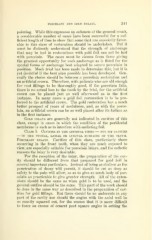Page 683 - My FlipBook
P. 683
POECELAIN AND GOLD INLAYS. 341
pointing. While this expresses an estimate of the general result,
a considerable number of cases have been successful for a suf-
ficient length of time to show that some that are especially favor-
able to this class of restoration should be undertaken. But it
must be distinctly understood that the strength of anchorage
that may be had in restorations with gold foil can not be had
with porcelain. The cases must be chosen from those giving
the greatest opportunity for such anchorage as is fitted for the
special forms of anchorage best adapted to secure porcelain in
position. Much trial has been made to determine this, but it is
yet doubtful if the best plan possible has been developed. Gen-
erally the choice should be between a porcelain restoration and
an artificial crown. Therefore, with patients who are old enough
for root fillings to be thoroughly good, if the porcelain fails,
there is no actual loss to the tooth by the trial, for the artificial
crown can be placed just as well afterward as in the first
instance. In many cases a gold foil restoration is to be pre-
ferred to the artificial crown. The gold restoration has a much
better prospect of years of usefulness, and, as with the porce-
lain, an artificial crown can be as well placed after its failure as
in the first instance.
Gold inlays are generally not indicated in cavities of this
class, except in cases in which the condition of the peridental
membrane is such as to interfere with malleting foil.
Class 5. Cavities in the gingival thied — not pit cavities
in the buccal, labial ob lingual suefaces of the teeth.
PoECELAiN INLAYS. Cavitics of tMs class, particularly those
occurring in the front teeth, when they are much exposed to
view, are especially suitable for porcelain inlays, and for esthetic
reasons the inlay is very desirable.
For the reception of the inlay, the preparation of the cav-
ity should be different from that prepared for gold foil in
several important particulars. Instead of being as shallow as the
penetration of decay will permit, it should be cut as deep as
safety to the pulp will allow, so as to give as much body of por-
celain as practicable to give greater strength. All of the exten-
sions should be the same as when gold is to be used, and the
general outline should be the same. This part of the woi'k should
be done in the same way as described in the preparation of cav-
ities for gold fillings. But there should be no imdercuts in any
part of the cavity nor should the angles with the axial wall be
so exactly squared out, for the reason that it is more difficult
to force an excess of cement past square angles in setting the


